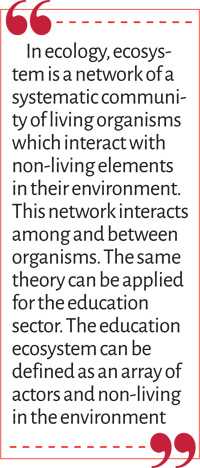Monday Apr 07, 2025
Monday Apr 07, 2025
Saturday, 2 January 2021 00:01 - - {{hitsCtrl.values.hits}}
 Overview
Overview
Real GDP growth in Sri Lanka was exhibited a declining trend over past five years and it was recorded as 2.3% in the last year. In such environment, one of main macroeconomic targets that was set up in ‘Vistas of Prosperity and Splendour’ is to achieve a GDP per capita exceeding $ 6,500.
However, the goal is partly unrealistic alone with the present governance system and economic disparities triggered by the coronavirus. This article is to spell out one of the major contributing sectors to achieve long-run economic growth where many governments failed to address, which is the education sector.
Starting with the labour market, labour productivity and per capita GDP show a very similar trend historically, inferring that the labour market is functioning well when the economy is heating up. Thus, one of the main charioteers to escalate the growth is to foster demand and supply in the labour market.
In the country, the majority of the population are employed in the services sector, which is 47% and remaining is employed in agriculture and industry sectors. Agricultural sector employed population declined at a rate of 3% while industry and services were recorded a marginal growth of 1% in the post-war era.
Non-agricultural employment has increased over the past decade, signifying a sectorial shift owing to major investment composition in respective sectors. Women participation in the job market has declined since 1990 and it was estimated as 35% at present. Such falloff is one of main reasons to decline the overall labour force participation in the country and mainly associated with high level of spousal income, cultural factors, and other job market specific behaviours.
However, vulnerable employment was stagnated during the past two decades and it has remained unchanged at 40%, despite the fact that there were no major shifts in informal sector of the economy in Sri Lanka. Further, economic growth was less employment-intensive during the post-war era when comparing to other periods.
During 1996-2002, 1% increase in GDP was associated with 1.16% increase in jobs, while in the post-war era it declined to 0.16%. Sri Lanka is also losing many workers to foreign employment. The rate shows a steady incline from 2002, presenting a less attractive domestic employment environment for some workers.
The dilemma
On top of the mentioned behaviours, Sri Lanka is shadow walking towards another major dilemma. The country is above to facing the risk of rapidly growing elderly population when it comparing to other economies in the same basket. The population will grow older in next few decades as a result of longevity and decline in fertility rate.
In 2035, population that is above the retirement age will be 20% of the total, where it is a 65% increase comparing with 2015 census. The present demographic transition started in 1960s. Universal healthcare and education combined with later marital age, sterilisation, and traditional methods of pregnancy prevention have reflected with current growth rates.
Population aging will be imposed many challenges to economic growth. Owing to such transition, working age residents will shrink in next decade creating a space to carter the growth of the GDP. In addition, burden to the Government will be increased in terms of social welfare allocations.
In response, Government has to increase its fiscal space for pension, healthcare, subsidies and benefits, and other long-term care transfers. Next to increase is expenditure, the tax revenue will decrease on par with declining working age population.
The stagnation of economically active population has to be balanced with the upsurge of labour productivity, thus the only solution is to maintain the historical rate of economic growth. However, the intention ought to be to fast-track the growth. A younger labour force can attain a greater sectorial mobility and can adopt for new technologies.
Although, if the estimated rates of declining dynamic workforce are to be continued, it would adversely affect development even if capital accumulation and technology tend to grow. Therefore, increase in space for education, capacity building, and skill transformation must be emphasised in the future budget speeches. 
Proposals
In Sri Lanka, the education structure (life cycle) is consisting of three stages, namely, early childhood development, primary and secondary education, tertiary and vocational education. Around 335,000 students are gaining admissions to grade 1 in each year. It was estimated that nearly 200,000 students are dropping out from the first and second stage of education lifecycle.
Consequently, 60% of less productive labour is adding periodically to country’s labour force while 93% of employers were seeking workers without any specifications, showing the labour market also signalling through routine adjustments for the vacuum.
There were five key policies formed from 1939 in Sri Lanka with the objective was to enhance the education sector. However, none of the reformations have addressed the gap in labour productivity and negligence of unskilled population were continued over the years. According to some studies conducted by sector experts in Government and non-Government organisations, they have recommended many suggestions. Several vital facts that were spelled out are summarised below.
Increase equitable opportunities for general education, primary and secondary, including introducing science and technology, unbiased allocation of qualified teachers, and regulating private sector education. Nevertheless, creating awareness regarding tertiary education and job market is the baseline to meet the skill gap
Expand tertiary education arching with increase in quality standards, generating income of public universities through external graduate, and other certificate programs. Notably, Government has to increase student enrolment for Government universities and increase private universities that offer degrees and certificate programs
Development of TVET sector through expansion of direct financing to improve the facilities and linking vocational systems with market actors in the subsectors of the economy
For the youth, after completion of secondary education or tertiary education, they have only two options; to be a part of the entrepreneurial world or enter into the job market. As previously mentioned, there are more than 60% of less productive youth population who are willing to enter in to either of category, where they came across through an education system that only preparing students for higher education not for the global competitiveness.
Many education systems around the world have enabled the vocational training in their primary and secondary education cycles. E.g. Finland education system facilitate the vocational education in the latter part of the secondary education and China is delivering vocational education from the junior middle school which after six years of schooling.
Way forward
None of the previous governments attempted to change the education system drastically. Lobbying pressure of counterparties is one of the major factors that all governments failed to amend current education system.
Consequently, alternative measures must be taken to overcome the ever-escalating disparity in the labour market. Along with the compressed space of the Government, it cannot act as a single stakeholder to solve this issue. Therefore, policymakers have to attempt to create a more holistic approach by inheriting different dimensions of a one structure.
In ecology, ecosystem is a network of a systematic community of living organisms which interact with non-living elements in their environment. This network interacts among and between organisms. The same theory can be applied for the education sector. The education ecosystem can be defined as an array of actors and non-living in the environment (E.g. resources, tools, infrastructure etc.).
The following represent a simple model of an education ecosystem. The education lifecycle surrounded by six integral components of the ecosystem. There are three stages of the education system in Sri Lanka also brought out as ‘education lifecycle’ in this article, namely Primary, Secondary, and Tertiary. The six components to strengthen the life cycle can be introduced as,
1. Government policy
2. Labour market
3. Infrastructure support
4. Human capital
5. Culture
6. Finance
The stakeholders in the ecosystem known as the actors who are strengthening the network, can be instituted as Government, private, non-Government, and donor community.
A major role is owned by the central Government while it has to partner with all other stakeholders to strengthen the network. Other stakeholders could signal to the environment to keep it alive in terms of program planning and implementation, under the context of increase space for education, capacity building, and skill transformation.
Factors of production in the modern world including land, labour, entrepreneurship, and capital required a more productive working population to increase its rewards involving rent, wages, profit, and interest. If the authorities would not react in the near future, Sri Lanka has to move towards trade agreements that are centred around skills and knowledge transfers.
(The writer is currently working at a major donor-funded project and could be reached via email at [email protected].)
Figure (Education Ecosystem)
Discover Kapruka, the leading online shopping platform in Sri Lanka, where you can conveniently send Gifts and Flowers to your loved ones for any event including Valentine ’s Day. Explore a wide range of popular Shopping Categories on Kapruka, including Toys, Groceries, Electronics, Birthday Cakes, Fruits, Chocolates, Flower Bouquets, Clothing, Watches, Lingerie, Gift Sets and Jewellery. Also if you’re interested in selling with Kapruka, Partner Central by Kapruka is the best solution to start with. Moreover, through Kapruka Global Shop, you can also enjoy the convenience of purchasing products from renowned platforms like Amazon and eBay and have them delivered to Sri Lanka.
Discover Kapruka, the leading online shopping platform in Sri Lanka, where you can conveniently send Gifts and Flowers to your loved ones for any event including Valentine ’s Day. Explore a wide range of popular Shopping Categories on Kapruka, including Toys, Groceries, Electronics, Birthday Cakes, Fruits, Chocolates, Flower Bouquets, Clothing, Watches, Lingerie, Gift Sets and Jewellery. Also if you’re interested in selling with Kapruka, Partner Central by Kapruka is the best solution to start with. Moreover, through Kapruka Global Shop, you can also enjoy the convenience of purchasing products from renowned platforms like Amazon and eBay and have them delivered to Sri Lanka.